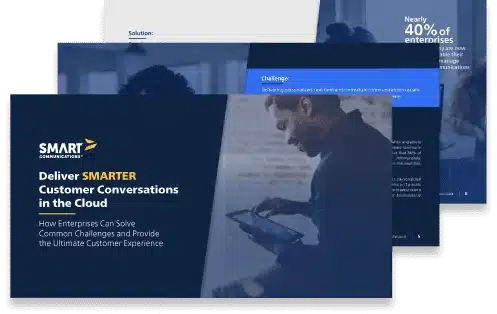What Are Enterprise Forms and How Are They Different from Most Web Forms?
By Smart Communications
In today's digital age, forms play a crucial role in capturing personal, first party data and facilitating processes that have the potential to create seamless customer interactions and provide faster resolution. Basic web forms often fall short in meeting the complex requirements of enterprise organizations especially when it comes to versatility, security, true automation. This is where enterprise forms technology comes into play.
In this article, we will explore what enterprise forms are, highlight the challenges organizations face with form processes, discuss the key capabilities needed to enhance customer experience and operational efficiency, and go over what to look for in a vendor.
Why Most Web Form Tools Fall Short in Meeting Enterprises' Needs
Most web form tools are designed to capture information as part of a one-directional interaction—things like completing a survey or job application. While this will work for situations where there is only one path an end user can take, they are missing the capabilities needed to support applications that have different outcomes based on the information someone provides—applications such as lending, onboarding, enrollment and claims.
Businesses around the world—specifically businesses in heavily regulated industries like healthcare, financial services, and insurance—deal with intricate approval processes, large volumes of highly personal data, and the need for seamless integration with their other existing systems. Basic web form tools simply do not offer the capabilities needed to meet these demands effectively. Let’s look at some other current challenges facing companies.
Challenges that Enterprises Face with Paper Forms
From the amount of effort required by customers and employees to physically fill out forms to the difficulties companies face extracting the data, storing the forms, and managing all of the additional documentation required, enterprises are incurring heavy costs and introducing severe risk as they try to manage these outdated methods 20 or more years after they were first introduced—when volumes were much lower and no other options existed. Additionally, concerns around data security, regulatory compliance, and the environmental impact of paper consumption and waste are adding to the sense of urgency to the need for change.
Looking at these processes more through the lens of the employees involved in them, in an increasingly remote work environment, the limitations of physical forms hinder collaboration and productivity for distributed teams. Considering these obstacles, enterprises are seeking innovative solutions to streamline their form processes and overcome these challenges.
-
Time-consuming and labor-intensive: Manual and paper-based forms require significant time and effort to create, distribute, collect, and process. Employees and customers must physically fill out the forms, resulting in delays and reduced productivity. Moreover, manual data entry can be error-prone, leading to inaccuracies and the need for additional validation steps. Enterprise forms, on the other hand, can be completed within minutes.
-
Inefficient data storage and retrieval: Storing paper-based forms poses challenges in terms of organization, storage space, and retrieval. Enterprises often struggle with locating and accessing specific forms, resulting in wasted time and frustration. Additionally, paper forms are susceptible to damage, loss, or misplacement, leading to potential data loss.
-
Limited data security: Paper forms lack the security measures provided by digital systems. Sensitive information can be easily compromised if forms are mishandled, lost, or accessed by unauthorized individuals. Compliance with data protection regulations, such as the General Data Protection Regulation (GDPR), becomes more difficult when relying on manual processes.
-
Lack of real-time visibility: Paper forms are not conducive to real-time data tracking and visibility. Enterprises may face challenges in monitoring the progress of form submissions, identifying bottlenecks, or obtaining timely insights for decision-making. This lack of visibility can hinder effective workflow management and hinder responsiveness to changing business needs.
-
Higher costs and environmental impact: Manual and paper-based forms incur costs related to printing, storage, distribution, and disposal. These expenses can add up significantly, especially for large enterprises with extensive form requirements. Moreover, the environmental impact of paper consumption and waste contradicts sustainability initiatives, some of which are being mandated by state and local regulators.
-
Reduced collaboration and remote work challenges: Physical forms restrict collaboration and pose challenges for remote teams. Sharing, reviewing, and collaborating on paper-based forms requires physical presence, hindering the ability to work remotely or in distributed teams and significantly impacting a remote workforce’s productivity. This limitation becomes more pronounced in today's globalized and digitally connected business environment, especially when work flexibility leads to greater happiness, according to one source, thus, higher job satisfaction.
Not sure how your company can move forward with enterprise forms? Read our guide for more about the cost-savings and overall benefits of investing in a digital forms management solution.
Impacts to Customer Effort and Experience
Many enterprises still rely on manual processes and that include outdated technologies like fillable PDFs and non-intelligent forms. These older tools not only drive internal inefficiencies related to data accuracy and handling time but they also detract from the user experience. The manual data entry still required on the back end, lack of automation, and absence data integration and validation result in errors, delays, and frustration for customers and employees. And, as we mentioned earlier, there is a sense of undue effort felt by customers and employees that diminishes their overall customer experience.
Let’s pretend you’re a prospective client at a bank and you want to apply for a new commercial loan. You’re asked to fill out a general commercial loan application, then another form related to the assets being used to back that loan—and half the information is the same information you just filled out on the first firm. Then you find out what additional documentation you need. So, home you go and, a week later, you’re back at the bank, documentation in hand, and…wait, what’s that? Another form? You brought the wrong tax document? . This increased frustration rate can lead to abandonment and less likelihood that you’ll recommend the financial institution to anyone else.
Desired State - Creating a Better User Experience
Enterprises can easily create a better user experience by streamlining their form processes—but it may not feel like it would be easy, with so many forms, so many technologies, and so many teams involved. They seek solutions that provide intuitive interfaces, automate repetitive tasks, ensure data accuracy, and integrate seamlessly with their existing systems. Enterprise forms are designed to address these requirements and provide a comprehensive solution for efficient form management. Customer experiences can vary based on anything from an individual customer’s expectations to their demographic and/or comfortability with tech solutions. Cloud solutions are typically more intuitive, allowing for ease of use across multiple demographics and user levels. This is especially true when it comes to creating an easy-to-navigate forms experience, a feat that enterprise forms can certainly help with.
Key Capabilities Needed by Enterprises
To effectively modernize and digitalize form processes, organizations are looking for innovative, sophisticated tools to help them reduce the amount of effort it takes for customers to do business with them. We’re here to help guide that process by offering a few key capabilities to look for, below:
No More Manual PDFs
Enterprise forms eradicate the necessity for manual PDFs by offering dynamic, web-based forms that are conveniently accessible and can be completed online. Users are relieved of the burdensome tasks of printing, scanning, or faxing forms, resulting in significant savings of time and resources. Moreover, enterprise forms provide the flexibility to modify and update forms effortlessly, eliminating the need to redistribute physical copies. This not only ensures a safer environment for managing and securely storing customer data but also contributes to minimizing paper waste and supporting your company's commitment to reducing its carbon footprint, thereby promoting sustainability and environmental consciousness.
Low-Code Form Builder
Enterprises require a low-code form builder that empowers non-technical users to create and customize forms without extensive programming knowledge. With a user-friendly interface and drag-and-drop functionality, employees from various departments can quickly design and deploy forms tailored to their specific needs. Because of the nature of low-code functionality, IT involvement is next to none, allowing the IT department to focus on more strategic and innovative projects.
Integration with Legacy Systems / Disparate Systems
Seamless integration with legacy systems is of utmost importance for enterprises. Enterprise forms must seamlessly integrate with pre-existing databases, core systems, CRM systems, and other applications, thereby guaranteeing the smooth flow of data and eliminating the need for manual data entry. By establishing connections between disparate systems, enterprise forms facilitate efficient information sharing, leading to enhanced operational efficiency across the organization.
Field Validation to Improve Data Accuracy
Data accuracy is paramount for enterprises. Enterprise forms should include robust field validation capabilities that verify the correctness and integrity of entered data from the point of entry. Automated validation rules, such as data type checks, range limits, and mandatory field validations, help reduce errors and ensure high-quality data collection.
Workflow & Automation to Accelerate Back-End Processes
Enterprises often deal with complex workflows involving multiple stakeholders and back-end processes. Enterprise forms offer workflow and automation capabilities that streamline these processes. By defining rules and triggers, forms can automatically route submissions to the appropriate departments, initiate approval workflows, and trigger backend actions, reducing manual intervention and accelerating process completion.
SmartIQ offers a robust low-code form builder, seamless integration with existing systems, advanced field validation options, and powerful workflow automation features.
There’s more to learn about the benefits of low-code functionality. Read more in this blog about how SmartIQ enhances customer experience, operational efficiency.
Case Study: The Bancorp Delivers a Fast, Easy Digital Client Experience for Loan Origination
Based in Delaware, The Bancorp is a payment services provider and specialized lender. It provides securities-backed lines of credit, insurance-backed lines of credit and advisor financing to the independent wealth management channel.-With increased competition from banks in that space, they were looking to set themselves apart and set ambitious goals.-Some of those include:
-
Doubling their market share
-
Quadruple the company’s assets and revenue
-
Increase profits tenfold
To do this, they knew they needed to create an exceptional client experience that made it simple and fast for clients to borrow from their portfolios.
This meant they had-to-modernize and automate their manual legacy workflow processes-which included a lot of paper, postage, and data entry. From start to finish, it took between 20 and 30 days on average to complete a loan approval process.
With-SmartIQ, The Bancorp's loan origination forms are pre-populated with known customer data, and advisors can complete the form on behalf of their client online. Within 5-7 minutes, the loan package is automatically generated, personalized, and delivered via the customers’ preferred channel. The customer can quickly sign the loan package via eSignature to complete the process.
As a result of this new lightning-fast process, The Bancorp has increased their loan volumes by 400%, and are projecting a 750% ROI. In addition, they have reduced “Not in Good Order” rates down to nearly zero, and have eliminated costs associated with document printing, postage and shipping.-
The Bancorp continues to add new lending lines and expand the use of-SmartIQ-across the enterprise.-
Here’s What to Consider When Looking for an Enterprise Form Solution
If you’re in the market for a new enterprise forms solution, here are some things you should consider before making the investment:
Centralization
Ensure the solution you select can be applied across a variety of internal and customer-facing use cases across your entire business. Centralizing your forms processes unlocks a range of powerful benefits for organizations seeking to streamline their operations and ensure consistency across forms. With a centralized approach, making changes to forms in real-time becomes a breeze. Whether it’s updating a logo, modifying regulatory language, or implementing brand and theme changes, you can make the change only once and apply it across all forms in real-time. This eliminates the tedious and time-consuming process of updating each form individually, ensuring your organization maintains a unified and up-to-date brand image. Moreover, centralized content management allows for easy collaboration and governance, enabling teams to work together seamlessly and maintain control over the entire forms experience.
User-Friendly Experience
Opt for a form builder with an intuitive interface that even users with limited coding knowledge can navigate effortlessly. This will save you time and resources during form creation and management. Solutions that offer drag-and-drop abilities, for instance, make it easier to personalize and customize forms.
Customizations
Look for an enterprise form builder that provides extensive customization options, allowing you to design forms that align with your branding without requiring you to have a coding degree. You should also have the flexibility to customize your form creation, management, and delivery based on unique customers' needs.
Security and Compliance
Ensure that the form builder you choose prioritizes advanced security measures such as data encryption, GDPR, and HIPAA compliance. This guarantees the protection of sensitive information and helps you adhere to industry, federal, or local regulations.
Robust Workflow & Automation Capabilities
By selecting an enterprise forms solution with robust workflow and automation, organizations can effectively manage complex workflows that involve multiple stakeholders and intricate processes. By leveraging the power of automation, enterprise forms enable the seamless routing of form submissions to the right departments, initiate automated approval workflows, and trigger backend actions based on predefined rules and triggers. This reduces the need for manual intervention, minimizes delays, and expedites process completion.
Collaboration and Access Control
Leading enterprise form solutions facilitate teamwork by enabling multiple users to collaborate on forms from anywhere they are, share data in real time, and manage access-level controls. This is critical for hybrid or fully-remote workforces that need to offer flexibility to employees and efficiency/security to customers.
Seamless Integrations
Look for a solution that has partnerships with leading software vendors, like Salesforce and industry core systems like Guidewire or Pega. This ensures smooth data transfer and boosts overall productivity.
Conclusion
Enterprise forms offer a superior alternative to traditional web form tools for meeting the unique needs of enterprises, giving customers the freedom seamlessly communicate across unique member journeys. By eliminating manual PDFs, providing low-code form builders, enabling integration with legacy systems, ensuring field validation, and offering workflow automation, enterprise forms help companies streamline processes, enhance data accuracy, and improve the user experience. Leveraging advanced solutions like SmartIQ™, enterprises can revolutionize their form management and drive operational excellence in today's digital era.



